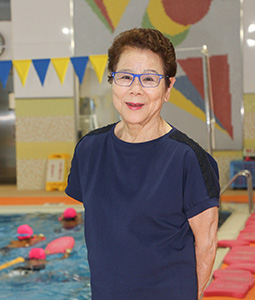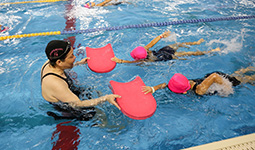Home > Highlighting JAPAN > Highlighting Japan October 2019 > THE SPORTING LIFE
Highlighting JAPAN


Swimming for Life
Satoko Takeuji, bronze medalist at the 1960 Rome Olympics, is a member of the International Swimming Hall of Fame. Since her retirement as a top class athlete, she has taught swimming to children with asthma.
As a child, Satoko Takeuji loved playing and swimming in local ponds and rivers. Victory in an elementary school swimming competition prompted her to start serious competitive swimming at middle school. In her first year of high school she took part in the Asia championships, earning first place in the 100 meters backstroke.
In her third year of high school she appeared at the 1960 Rome Olympics and took bronze in the same event. At the 1964 Tokyo Olympics she missed out on a medal with a fourth place yet achieved the satisfaction of a 0.8 second improvement on her personal best.
“It’s finally over, I thought. It’s a personal best so I should be proud,” says Takeuji.
Following her retirement, Takeuji's eldest daughter, then in the first year of elementary school, suffered an asthma attack, which spurred her to start swimming lessons for children with asthma. One of the doctors she met during her daughter’s treatment told her, “It’s generally assumed that swimming is effective as part of asthma treatment, but I want data to prove it. Please help me.”
Takeuji worked with the doctor and started swimming lessons at a public pool in cooperation with doctors. Thanks to her submitting data from the classes to what is now the Ministry of Health, Labour and Welfare, the effectiveness of swimming for asthma was recognized, and a few years later the hospital set up a pool specially for children with asthma.
The classes have now been running in Edogawa City, Tokyo for thirty-one years since 1989. They are held twice a week on Tuesdays and Thursdays, and around 120 children with asthma take part.
“Children with asthma can tend to be withdrawn. But when they get involved with swimming and gradually get better at it, you can see how their faces fill with confidence. That’s what makes it all worthwhile for us,” says Takeuji.
Before taking classes, the children take a peak flow test, breathing in fully then blowing out into a tube to measure how fast their lungs can expel air and thus how open their airways are. After their asthma condition has been checked, they change into swimsuits, are divided into four classes from beginner to advanced, and the practice begins. Each of the four classes has four instructors. There is also a doctor and a nurse by the side of the pool, so any sudden asthma attacks can be handled safety. At first, some children cry and try to run away. But they start by sitting at the side of the pool and gradually get used to the lessons; and by six months most of the children can swim.
“It’s very difficult for children who don’t know when they might have an asthma attack to attend a class each week and exercise. But if they overcome that and keep going for several years, the attacks almost completely stop. Swimming is good for abdominal breathing. Also, since the air in swimming pools is very moist it helps to remove excess phlegm, which makes it harder for asthma attacks to happen. Exercise increases children’s appetites and they start to sleep deeply at night. When that happens, they really start to enjoy swimming and they come to classes happily,” says Takeuji.
Even now at 77 years old, Takeuji competes in Masters swimming contests.
“You can start swimming at any age,” she says. “I want swimming to make people’s lives fun and fulfilling. That’s why I want to continue teaching.”
Takeuji has spent much of her life so far swimming; and she intends to keep on swimming.
© 2009 Cabinet Office, Government of Japan








